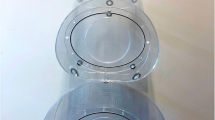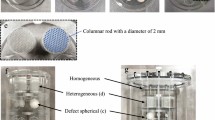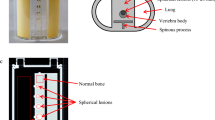Abstract
Purpose
A phantom study was conducted to evaluate the feasibility of body contour definition with Compton scatter photons from extemal sources of technetium-99m pertechnetate (Tc-99m) to create a fusion image of CT and SPECT images.
Methods
External sources of 1 mCi (37 MBq) Tc-99m were placed on each collimator, and bodycontour SPECT images were obtained with an energy window of 100 keV±25% for detecting 90° and 180° Compton scatter photons of Tc-99m from the body surface in water-filled cylindrical and hexagonal phantoms, and in a chest phantom with a Tc-99m-avid simulated lung nodule and multimethod surface markers. In the chest phantom, each transaxial SPECT slices was registered with the corresponding CT slice by using image-matching soft ware. A summation of the registered images yielded a three-dimensional (3-D) fusion image of this phantom.
Results
This method clearly visualized the body contour on all the SPECT slices in all the phantoms except for the complex hexagonal phantom. There was no significant difference between the known and SPECT-measured diameters of the cylindrical phantom. The fit of CT and SPECT images of the chest phantom was achieved with a mean alignment error of 5% in visual inspection, which was improved to 0.2% after correction of the magnification of the SPECT images according to the resultant dimensional differences. The 3-D fusion image of this phantom effectively visualized the anatomic location of the lung nodule and surface markers.
Conclusion
This simple method effectively provided boundary information on the cold phantoms. Although further improvements in the registration technique with CT images are desirable, the body-contour SPECT image obtained by this method has the potential for accurately creating a 3-D fusion image with CT images, and is a feasible way of anticipating the anatomical localization of a target tissue.
Similar content being viewed by others
References
Berstrom M, Litton J, Eriksson L., et al. Determination of object contour from projection for attenuation correction in cranial positron emission tomography.J Comput Assist Tomogr 6: 365–372, 1982.
Webb S, Flower MA, Ptt RJ, Leach MO. A comparison of attenuation correction methods for quantitative single photon emission computed tomography.Phys Med Biol 28: 1045–1056, 1983.
Hosoda M, Wani H, Toyama H, Murata H, Tanaka E. Automated body contour detection in SPECT: Effects on quantitative studies.J Nucl Med 27: 1184–1191, 1986.
Jaszczak RJ, Chang LT, Stein NA, Moore FE. Whole-body single-photon emission computed tomography using dual large-field-of-view scintillation cameras.Phys Med Biol 24: 1123–1143, 1979.
Macey DJ, DeNardo GL, Denardo SJ. Comparison of three boundary detection methods for SPECT using Compton scattered photons.J Nucl Med 29: 203–207, 1988.
Parsai EI, Ayangar KM, Dobelbower RR, Siegel JA. Clinical fusion of three-dimensional images using Bremsstrahlung SPECT and CT.J Nucl Med 38: 319–324, 1997.
Siegel JA, Zeiger LS, Order SE, Wallner PE. Quantitative Bremsstrahlung single photon emission computed tomographic imaging: use for volume, activity and absorbed dose calculations.Int J Radiat Oncol Biol Phys 31: 953–958, 1995.
Siegel JA. Quantitative Bremsstrahlung SPECT imaging: attenuation-corrected activity determination.J Nucl Med 35: 1213–1216, 1994.
Gullberg GT, Malko JA, Eisner RL. Boundary determination methods for attenuation correction in single photon emission computed tomography.In Emission Computed Tomography: Current Trends, Esser PD, ed., New York, The Society of Nuclear Medicine, pp. 33–53, 1983.
Larsson SA. Gamma camera emission tomography.Acta Radiologica 363 (suppl): 1–75, 1980.
Huang SC, Carson RE, Phelps ME, Hoffman EJ, Schelbert HR, Kuhl DE. Boundary method for attenuation correction in positron computed tomography.J Nucl Med 22: 627–637, 1981.
Maeda H, Ito H, Ishii Y, Mukai T, Todo G, Fujita T, et al. Determination of the pleural edge by gamma ray transmission computed tomography,J Nucl Med 22: 815–817, 1981.
Malko JA, Gullberg GT, Kowalsky WP, Van Heertum RL. A count-based algorithm for attenuation-corrected volume determination using data from an external flood source.J Nucl Med 26: 194–200, 1985.
Dey D, Slomka PJ, Hahn LJ, Kloiber R. Automatic three-dimensional multimodality registration using radionuclide transmission CT attenuation maps: A phantom study.J Nucl Med 40: 448–455, 1999.
Nishiyama Y, Wakimura K, Yamamoto Y, Takahashi K, Kawasaki Y, Satoh K, et al. 1-123 SPECT-imaging with body outline using convenient lightweight source.KAKU IGAKU (Jpn J Nucl Med) 34: 119–125, 1997. (Japanese)
Author information
Authors and Affiliations
Rights and permissions
About this article
Cite this article
Suga, K., Matsunaga, N., Kawakami, Y. et al. Phantom study of fusion image of CT and SPECT with body-contour generated from external Compton scatter sources. Ann Nucl Med 14, 271–277 (2000). https://doi.org/10.1007/BF02988209
Received:
Accepted:
Issue Date:
DOI: https://doi.org/10.1007/BF02988209




